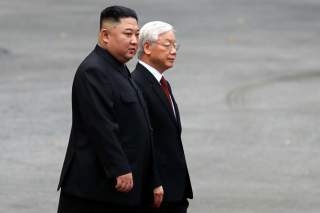The Hanoi Summit – We Asked Bruce Bennett What Happens Next in U.S.-North Korea Relations
"If Kim is sincere about denuclearization, it is time for him to match his words with actions."
Editor’s Note: Looking for more opinions on where we go after the Hanoi summit? Check out all 80 expert takes on where U.S-North Korea relations go next here.
In the aftermath of the failed U.S.-North Korea summit in Hanoi, is North Korean Chairman Kim Jong-un sincere in his offers of denuclearization?
North Korea has been undermining the trust of those who are hopeful on denuclearization by its failure to make any reduction in its nuclear weapon threat, and by apparently increasing its production of nuclear weapons and building more ballistic missiles. Moreover, the Korean Workers Party has been giving presentations and screening a film to tell the North Korean elites that Kim will not give up the North’s nuclear weapons.
If Kim is not sincere, then U.S.-North Korea relations will have a very difficult future. After all, North Korea has been persistent in insisting that the United States take “corresponding measures” for the North’s actions. So if North Korea continues building nuclear weapons and ballistic missiles, corresponding measures could have the United States enhancing the existing financial sanctions against North Korea and also beginning serious information operations against the North. If the North’s nuclearization still continues, the U.S. government may eventually face some pressure to take military action to stop this continued “nuclearization.”
But if Kim is sincere about denuclearization, it is time for him to match his words with actions. In his New Year’s address, Kim said that the North had stopped producing nuclear weapons. Such a development would probably be sufficient for the United States to provide the North with some sanctions relief. But President Trump likely cannot provide that sanctions relief until he verifies that the North Korean nuclear weapon production has been frozen.
North Korea could allow International Atomic Energy Agency inspection teams to go to all of its key nuclear weapon production sites, confirm that production has indeed been terminated, and install monitoring devices to sustain production termination. Dismantlement of these facilities could be negotiated after such a production freeze.
While the United States wants a full declaration of the North Korean nuclear weapon program, the North could start by providing a list of the key nuclear weapon production facilities. There are probably ten or so of these, and their information could be provided on a half sheet of paper showing the names, locations, function, and capacity of each. Of course, North Korea is unlikely to provide a full list, so some form of challenge inspection would also be required. Then some sanctions relief and other corresponding measures could be possible.
Bruce W. Bennett is a senior international/defense researcher at the nonprofit, nonpartisan RAND Corporation.
Image: Reuters

